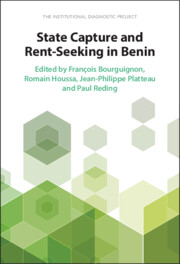Appendix 2 Contribution to Benin’s GDP of Re-exports to Nigeria
Golub (Reference Golub, Benjamin and Mbaye2012a, p. 215, 2012b, p. 1159) estimates that re-export activities to Nigeria contribute to 20 per cent of Benin’s GDP. Golub et al. (in Chapter 8 of this book) report a slightly lower figure of 18 per cent. Their estimates for employment effects range from 50,000 people directly involved (and possibly up to 100,000 people when those indirectly involved are also taken in account). These estimates on employment effects represent for the year of estimation (2005) about 8 per cent of employed workers in the three sectors susceptible to contribute to this trade – that is, commerce, transport, and finance – and 2 per cent of total employment in the economy.
To assess the consistency between the GDP and employment estimates, we reason in the following way. Estimated tax receipts from CBT are about 30 per cent of tax receipts (World Bank, 2009), which translates into an average of 4.5 per cent of GDP. Using 2006 data, we net out this share of GDP from the estimated global 20 per cent contribution to GDP and compute the net contribution in terms of gross value-added at factor costs. The resulting ratio is 17 per cent. We assume that this net contribution to value-added at factor costs originates 65 per cent in the commerce sector, 30 per cent in the transport sector, and 5 per cent in the finance sector. Using the respective productivity data reported in Table 2.2 (Haile, Reference Haile2018), we obtain an effect on employment amounting to 450,000 individuals, or 18 per cent of total employment in the economy. This huge effect on employment reflects to a large extent the low productivity in the commerce sector, which was noted in Section 1.2. It actually implies that about 80 per cent of people employed in this sector are supposed to be involved in CBT. Using 2015 data for the same scenario implies that the 20 per cent of GDP contribution of CBT represents an employment effect of 27 per cent of total employment (87 per cent of employment in the commerce sector). Again, the decrease in productivity in the commerce sector between 2006 and 2015 explains this difference. Using actual sectoral productivity data thus shows that the estimates of the contributions of CBT to GDP and to employment are inconsistent. It also shows that the 20 per cent of GDP estimate appears to be really excessive, when its implications for employment are assessed with realistic productivity levels.
As an alternative, we use the same approach, based on sectoral productivities, and reverse it. We explore a scenario in which we start from a specific hypothesis on sectoral employment in unofficial CBT. We arbitrarily assume that 25 per cent of workers in commerce, 20 per cent in transport, and 5 per cent in finance are active in unofficial CBT, this representing about 150,000 workers and 5.5 per cent of total employment in 2006. We obtain, under this hypothesis, a total contribution of unofficial CBT to GDP (i.e. indirect tax receipts included) of about 9.1 per cent in 2006. Repeating the exercise for 2015 we get 10.3 per cent. One could, however, argue that the national account productivities used in these calculations underestimate actual productivities in the informal trade. Because the latter involves a multiplicity of intermediaries and gives rise to specific costs, which includes bribery, the value-added per employee in this business can be expected to be larger. Assuming therefore that productivities are, say, 30 per cent higher in this specific informal trade than those reported in the national accounts, we obtain an estimated contribution of unofficial CBT to GDP of 10.4 per cent in 2006 and 12.1 per cent in 2015. All in all, a range of 10–12 per cent for the contribution of unofficial CBT to GDP thus seems a reasonable estimate.Footnote 55



